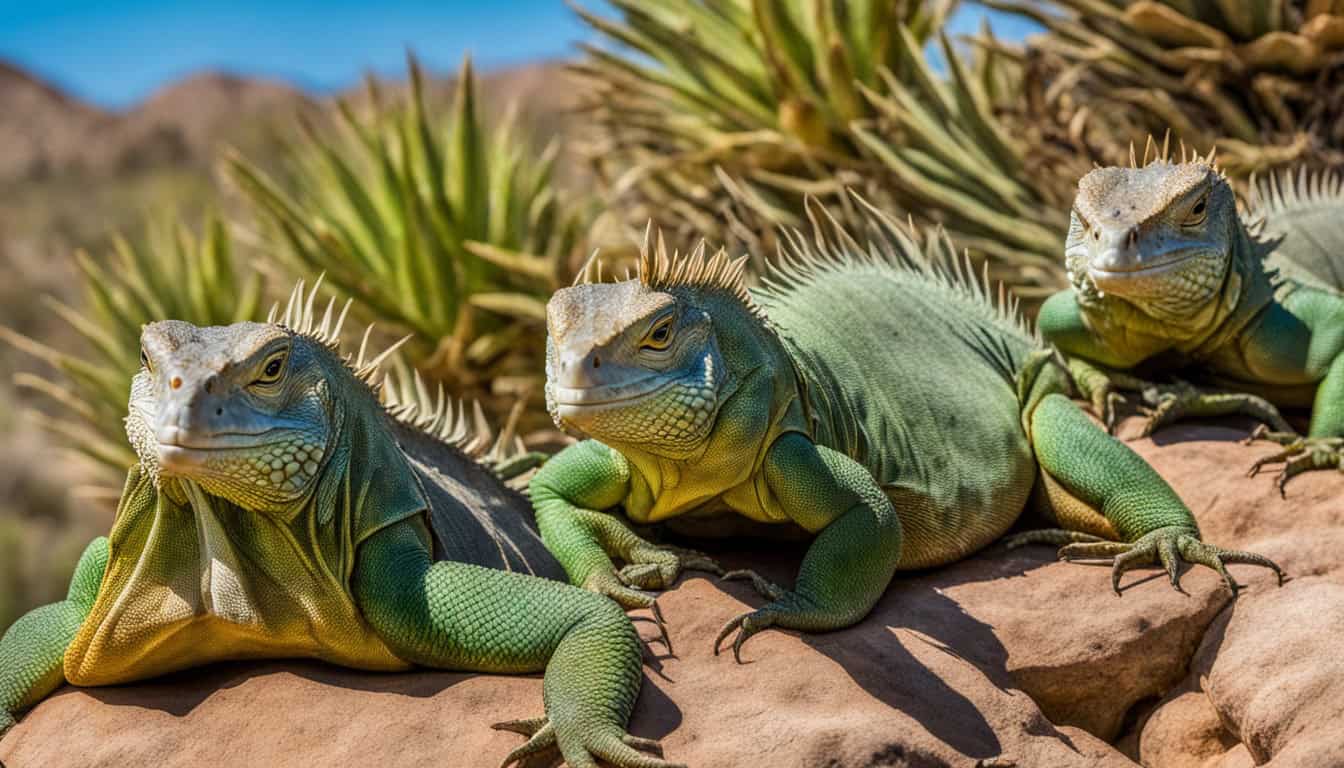You might be surprised to learn that there are no native iguanas in the USA. The Green iguana, often seen in Florida, is not native. It was brought over and has become an invasive species.
In the 1960s, the pet trade introduced these iguanas. They’ve managed to thrive in both suburban and urban areas. Their success has had a big impact on the environment, leading to actions to control their numbers and protect the ecosystem.
Understanding Iguanas and Their Native Habitats
Iguanas are amazing at fitting into different places. They like tropical areas but can also live in dry ones. They’re found near water too. This shows us the importance of knowing what kind of green iguana habitat they like.
The green iguana, also known as Iguana iguana, is quite unique among American iguanas. It’s widely distributed and has a big impact on nature. They mostly eat plants like leaves and fruits. Found from Central to South America and some Caribbean islands, they are key to their ecosystems.
Iguanas are not just land-dwellers. They are good swimmers and can climb trees well. These abilities help them live in many places. Knowing about their behaviors also helps us understand their big role in nature. This knowledge is important for managing them in areas where they are not native, like parts of the USA.
The table below shows the usual living spaces of American iguanas. It shares what makes these places special for them and their impact on nature:
| Habitat Type | Characteristics | Role in Ecosystem |
|---|---|---|
| Tropical Rainforests | High humidity, dense vegetation, abundant food sources | Seed dispersers, control of vegetation growth |
| Dry Forests | Seasonal water availability, sparse tree cover | Habitant for other species, aid in nutrient cycling |
| Near Water Sources | Rivers, streams, wetlands with lush vegetation | Stabilization of riverbanks, contributors to aquatic ecosystems |
Iguanas are very adaptable. They can really change the places they live in. Exploring their natural homes shows us how important they are for the environment.
Exploring Iguanas in Central and South America
Iguanas in Central and South America shine because of their variety and ability to adapt. The climate and different habitats there are perfect for these iguana species. They play a big role in keeping the ecosystem healthy.
Geographical Distribution
Iguanas are found in a big area, from southern Mexico to South America including countries like Brazil and Paraguay. They also live on some Caribbean islands. The wide iguana species distribution shows how well they can adapt. Understanding where they live helps us keep their natural environments safe.
Habitat Preferences
South American iguanas are really good at finding just the right home. They can live in the tropical rainforests, dry forests, and even in places touched by human hands. In Central America, iguanas are adapting to live near people, in towns and cities. This ability to live in various places can sometimes cause problems. It’s important to watch over them and make sure they don’t harm the environment.
The Concept of Native Iguanas
Iguanas are called “native” if they have grown in their home over many years. But, some iguanas in North America make this idea a bit tricky. That’s because they came from Central and South America, and the Caribbean rather than North America.
“To be classified as a native reptile species, the animal must have established its ecological role over a long period, contributing to the balance of its natural environment.” – Ecological Journal
In the USA, Green Iguanas, for example, are not from here. People brought them, and now they live in Florida and elsewhere. They can fit in well, but they can also harm local animals and plants by using the same resources.
It’s key to know what makes a species “native.” The long time they spend in an area, how they fit into nature, and what they do for the land all matter. Even though the North American iguanas came from somewhere else, they are making new homes where they are found now. This situation offers challenges and chances to learn more about nature.
Iguanas keep moving to new places because they can adapt well. Even though they are not originally from the United States, they show how nature is always changing. This change opens up new ways to think about caring for and enjoying these wonderful creatures.
Types of Iguanas Found in the United States
The United States is home to various iguana species introduced over time. Among these are the Green Iguanas, Black Spiny-Tailed Iguanas, and Knight Anoles. They bring unique issues to our local ecosystems. Their presence highlights the breadth of biodiversity and the effect of iguanas in the U.S.
Green Iguanas
In the US, Green Iguanas are quite common, especially in Florida. They are noted for their bright green color and size. Unfortunately, they’ve turned into a problem, causing ecological impacts. They feed on fruits, leaves, and flowers, damaging local greenery.
Black Spiny-Tailed Iguanas
The Black Spiny-Tailed Iguana is also a key player in the iguana species in America. It’s frequently seen in places like South Florida. Recognizable by its spiny tail, these creatures can be quite aggressive. Their digging poses a threat to the area’s buildings and roads, worrying city planners and locals.
Knight Anoles
Knight Anoles share many similarities with iguanas in looks and habits. They arrived mostly through the pet market, establishing themselves as an invasive species in Florida. Being predators, they harm local wildlife. This further complicates the issue of managing USA iguanas outside their natural range.
| Iguana Species | Key Characteristics | Impact on USA Ecosystems |
|---|---|---|
| Green Iguanas | Large size, vibrant green color | Vegetation damage, competition with native species |
| Black Spiny-Tailed Iguanas | Spiny tails, aggressive behavior | Infrastructure damage, ecological disruption |
| Knight Anoles | Large size, varied diet | Predation on native species, habitat competition |
Are there any native iguanas in the USA?
No iguana species are native to the United States, research shows. Iguanas in places like Florida are not from here. They are invasive from regions outside the USA. This is important to know when thinking about them in the U.S.
Even though iguanas are not native to the USA, they have adapted well. Especially in parts of Florida, they have thrived. However, their presence affects the area’s local wildlife and plants, including USA native reptiles.
Iguanas do so well here because the environment suits them. The weather is mild, there’s a lot of vegetation, and they have few natural enemies. But this is a challenge for the local species. So, managing the iguana population well is very important.
Here’s a look at how key factors affect iguanas in the USA:
| Factors | Impact on Native Ecosystem | Survival Conditions |
|---|---|---|
| Climate | Disruption of native reptile species | Supports iguana adaptation |
| Vegetation | Competition with native herbivores | Abundant food sources |
| Predators | Predation on native species | Lack of natural enemies |
It’s important to balance iguana adaptation with conserving USA’s native reptiles. Reflect on the effort required to manage iguana populations. This is crucial for protecting the local biodiversity from their invasive nature.
Introduction and Spread of Iguanas in Specific U.S. States
Green iguanas arrived in the United States, especially in Florida, in the 1960s. They got there through either intentional release or by escaping from the pet trade. This led to a large number of iguanas in parts of the USA quickly.
Florida’s Iguana Population
In Florida, the number of iguanas has grown a lot. This state is now a top place for studying how these invasives affect areas. Green iguanas have shown they can live in many different places, from people’s yards to wild spaces. This has helped them spread all over Florida.

Impacts of Population Growth
Florida’s growing iguana population has caused several problems. They eat a lot of plants, which hurts gardens and farms. They also dig burrows that can damage things like sidewalks and the sides of canals. And, they either compete with local animals for food or eat them, which messes up the natural balance.
Efforts to control the iguana numbers are underway. This includes teaching the public how to deal with iguanas, catching them in a way that doesn’t harm them, and changing the land to lessen their effect. The main goal is to reduce the damage the rising iguana population is causing in Florida and other parts of the USA.
| Impact | Description |
|---|---|
| Vegetation Damage | Destruction of ornamental plants and crops |
| Burrowing Activities | Compromising infrastructure like sidewalks and canal banks |
| Impact on Native Species | Competition with or predation on local wildlife |
Invasive Species: Green Iguanas in Florida
In Florida, the invasive green iguanas are causing big problems. They eat a lot of the local plants and veggies. This leads to a lot of damage around the area. Plus, they dig holes that can ruin roads and buildings.
Dealing with the iguanas is really important now. They are making life hard for both people and nature. The Florida government now allows for these iguanas to be removed safely. This change is part of a big plan to reduce their harm.
| Impact Area | Description | Control Measures |
|---|---|---|
| Vegetation | Widespread consumption of native plants and crops | Humane trapping and removal, vegetation protection |
| Infrastructure | Burrowing leading to erosion of sidewalks, walls, and canals | Reinforcement of structures, exclusion techniques |
Impacts of Invasive Iguanas on Local Ecosystems
Invasive iguanas have caused big issues in Florida’s ecosystems. They affect the plants, buildings, and animals there. So, people need to find ways to control them to protect the environment.
Vegetation Damage
Invasive iguanas really mess up the greenery, especially in urban areas. They love eating plants and fruits. This love for green snacks has led to a lot of plant loss. This harms the look of gardens and cities and affects plant types there.
Infrastructure Damage
Iguanas also harm structures, which often gets forgotten. Their digging can mess up foundations and canals. This digging can make the ground unstable for buildings and walkways. This problem adds to the repair costs for local areas and home owners.
Effect on Native Species
Local animals suffer from the iguanas’ invasion too. They are fighting for food and homes with creatures like tree snails. The iguanas also eat some of these unique animals. This puts more of these special animals at risk. So, it’s important to deal with the iguana issue to keep the local wildlife safe.
Dealing with invasive iguanas is very important. They cause harm to plants, buildings, and local animals. Finding good ways to manage them will protect the environment we all share.
FAQ
Are there any native iguanas in the USA?
No, native iguanas can’t be found in the USA. But, you can spot Green iguanas in Florida. They are seen as invaders there.
Where are iguanas native to?
Iguanas come from Central and South America. They live from southern Mexico down to Brazil and Paraguay. You can also find them on some Caribbean islands.
What kind of habitats do iguanas prefer?
Iguanas love many types of places. They fit well in tropical rainforests, dry forests, and near water. They are also okay in towns and cities, showing how adaptable they are.
What is the significance of understanding iguanas’ native habitats?
Knowing where iguanas come from helps us see their role in nature. It also shows the issues they can cause when they live in new places, affecting the local environment and structures.
Are there any American iguanas?
The term “American iguanas” talks about those in the Americas. But, the iguanas in the USA are not local. They have come from other places but have managed to live there well.
What are some types of iguanas found in the United States?
You can see Green Iguanas, Black Spiny-Tailed Iguanas, and Knight Anoles in the US. But, these types are not from the USA originally.
How did iguanas get introduced and spread in the USA?
Iguanas got to the USA mainly by being brought in as pets or being released on purpose. This happened a lot since the 1960s in Florida. They have since spread to many areas of the country.
How has the population growth of iguanas impacted Florida?
In Florida, the increase in iguana numbers has brought about big problems. They harm plants, make tunnels that mess up buildings, and they bother or eat local animals.
Why are Green Iguanas considered invasive in Florida?
Green Iguanas are invaders in Florida because they cause a lot of harm. They eat native plants, dig tunnels that hurt buildings, and compete with local animals for resources.
What kind of damage can invasive iguanas cause?
Invasive iguanas can ruin the environment by eating local plants and crops. Their burrows can mess up buildings. They also compete or hunt native animals.







